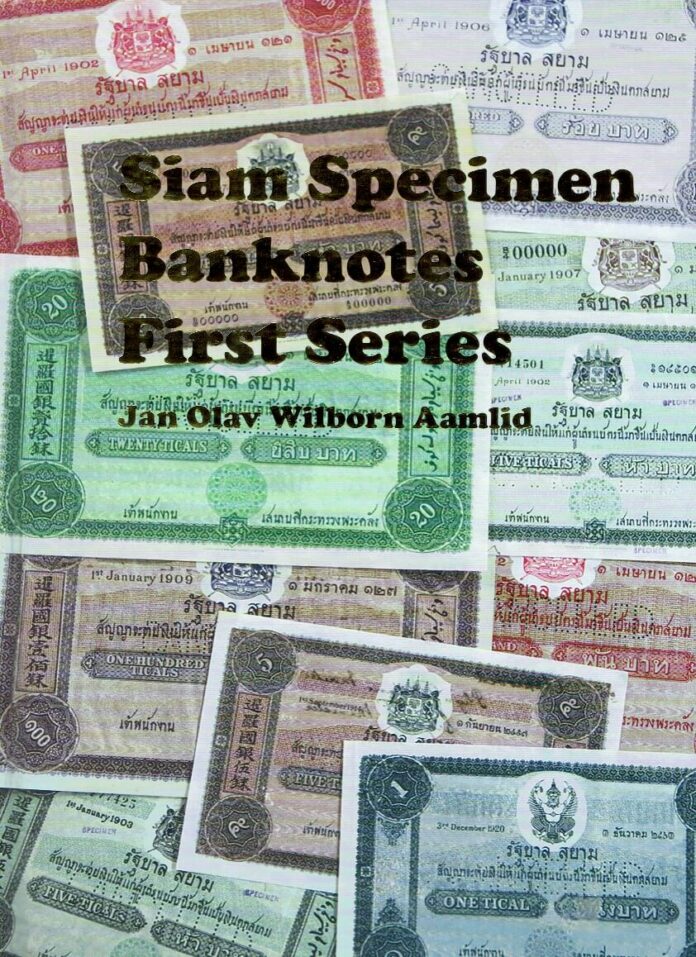
This is one topic that definitely won’t feature in any of the catalogues you have in your bookshelf: after many years of work, Jan Olav Wilborn Aamlid has published his catalogue of the specimens for Siam’s first banknotes, produced between 1902 and 1924. He knows more about this field than almost anyone else; after all, most of these pieces are unique and in his possession. But let’s start from the beginning.
Aamlid, born in Norway, has lived in Thailand since the 1990s, where he has continued the coin dealing career he began in his home country. He’s also made a name for himself as a collector. For 40 years, he has been fascinated by Thai banknotes, among other things – part of his important collection was displayed at the Bank of Thailand Museum in 2002. For the past 22 years, Aamlid has focussed on the specimens printed in this catalogue. So, what are they exactly?
What’s It About?
The catalogue is about banknotes of the Kingdom of Siam, which was renamed “Thailand” in 1939. More precisely, it’s about the banknotes of the “First Series”, issued between 1902 and 1924. This series was produced following radical monetary reforms and therefore has “first” in its name, despite the fact that there were already banknotes in Siam before it was issued.
If we want to be even more specific, Aamlid’s work is not about the banknotes themselves, but rather about the specimens that were produced as part of the approval process for the notes. The preface tells us, in passing, how this process worked: like many other countries, Siam had its banknotes printed abroad, in this case by Thomas de la Rue & Company in England, which still exists to this day. For each new type of banknote (and there were around 100 types in that period of over twenty years!), this company sent three specimens to Siam’s embassy in London. The embassy kept one copy and sent one to the Ministry of Finance in Bangkok. The third copy was returned to de la Rue as soon as production was approved – marked accordingly with a hand-written note “approved” and a signature on the otherwise blank reverse of the banknote. When de la Rue put parts of its house collection up for auction at Spink in 2000, Aamlid pounced and secured the majority of these unique signed specimen banknotes. Since then, he’s been striving to complete his collection with the pieces he didn’t manage to acquire at that auction.
A Splendid Collection Catalogue
Now, Aamlid presents his collection in this catalogue, written in English. It is not a complete catalogue of the specimen banknotes of the First Series, but rather a catalogue of Aamlid’s collection, as emphasised by the author himself. Just over 100 specimen banknotes, complete with catalogue numbers, as well as some other special issues, are described and printed in the large-sized, 246-page catalogue. Readers will not only find the banknotes in this catalogue, but also correspondence regarding the approval process for almost every banknote, also printed in a readable size. These letters add a great deal of value to the work, as they provide a fascinating insight into the process, problems that arose and questions that were discussed, for example, the possibility of including watermarks in the paper – an idea that was ultimately rejected.
The author repeatedly intersperses his catalogue with background information, including for example one chapter about an unsuccessful attempt by the USA to take over the printing of Siamese banknotes from de la Rue. Sections such as these reveal the author’s knowledge of the subject matter, which he has consolidated during research visits to the archives of Thomas de la Rue. With this work, Aamlid seemingly has brought to light some previously unknown facts about these issues.
If you’re looking for prices and valuations, you won’t find them here. The author explains in the preface that he has decided not to include this information, since all the banknotes are unique or extremely rare and could not be valued in this way. Aamlid plans to write more works on the banknotes of Siam and Thailand in future, which will also include prices.
There’s no fault to be found when it comes to the execution of the book. The printing quality and paper are very good and, from the outside, the large-sized, A4 book with its golden letters and slipcase looks downright splendid.
The subject matter is obviously very specific. If you’re interested in banknotes from the region of Southeast Asia or in the history of Thailand, you definitely shouldn’t hesitate to pick up this book. It’s also worth considering buying the catalogue if you’re interested in money and banknotes around 1900 in general, especially because it includes background information and the correspondence of de la Rue.
The catalogue only seems to be available online via the Spink Books website. You can buy it there for 55 pounds.
You can contact Jan Aamlid by email.




